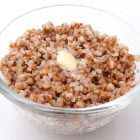Interview with Rhett Iseman Trull, editor of Cave Wall

I’m not sure the Ploughshares blog is the perfect venue to feature an interview with the editor of another literary journal, but I’m 100% sure that those who read Ploughshares 1) probably know about other literary journals, and therefore could (and I’d argue should) be interested in them, and 2) read good writing, and could (again, I’d argue should) be open to finding out more about or discovering other magazines to read (because there’s so much spare time for everyone, right? Exactly).
Regardless if it’s wise or not, here’s what’s happened: in the winter of 2007, Rhett Iseman Trull and her husband came out with the first issue of Cave Wall, a journal out of North Carolina which was (and remains, eight issues later) gorgeous, austere, and on the quietish side but in a welcoming, thrilling way. The journal has, for those of us real into this sort of thing, become one of those gotta-get-in deals, a journal quietly establishing itself as a venue in which some of the best contemporary poetry appears[1]. Rhett was kind enough to answer some questions about starting a lit journal and the editorial process.
Cutter: Can you talk about the start of Cave Wall? I’m sure–or, at least, I sort of hope–it’s a long-ish answer, but I’m especially curious about the two big questions attendant in a lit magazine: why’d you do it and how’d you pull it off?
Trull: Well, I started Cave Wall because I love other people’s poetry, and whenever I come across a poem I love, I get excited and want to share with everyone I know. Ever since I was in high school, I wanted to publish a literary journal. Back then, a friend and I went to the principal and asked if we could start a journal. He said if we got a teacher to sponsor and help us, the school would pay for it. So that was my first literary journal. I met my husband, Jeff, in 2003 and would always talk about how I’d love to publish a poetry journal one day. Meanwhile, I read and subscribed to a lot of journals; with a few of them, I liked almost every poem they published; but with most of them, it was more hit and miss. I kept saying, “I wish there were more journals that published the kind of poems I love.” One day I said that, and Jeff said, “Well, maybe we should start one. What would that look like? Let’s really talk about it. What would we need? How much would it cost us?” etc. We planned for a year, and then Cave Wall was born.
I started out by talking to several other editors to get ideas and find out how the process of publishing works. Jeff and I saved up some money to get started, and once I had the contributors lined up for the first issue, I sent out announcements to try to gather subscribers. For the first two issues, I solicited all the poems and the artwork. I wanted to give Cave Wall a strong foundation and show people the kind of poems I like.
Cutter: Can you talk at all about your aesthetic? This is, loosely, a trick question: I don’t know how to talk about my own aesthetic other than to list folks whose work I admire/enjoy, so I’m honestly curious if there’s a way—if you’ve figured a way—to be concise and clear about what your tastes are like. I’m especially curious about this in the context of CW: how do you decide what work’s included? Have there been poems you’ve liked but thought, well, that’s not Cave Wall enough? And the darker/scarier route, for me: is Cave Wall just fundamentally you? What are the pros and cons of that, if that’s the case?
Trull: This is good question but a tough one to answer. I think there is a necessary mystery involved in a person’s—and a journal’s—aesthetic. And I’m not sure it’s wise to try to dissect that mystery too much. I read everything I can get my hands on: poetry, fiction, nonfiction, plays, comic books. And it seems to me that poetry is the most diverse genre. There are more different types of poetry being written these days than I could list. And I try to be open to all styles and find that I love a variety of types of poems. I hope that is the aesthetic that applies to Cave Wall, as well. Basically, I don’t care if a poem is long, short, narrative, lyric, funny, sad, random, ordered, etc.—as long as it moves me. That’s what I want from poetry: to be moved in some way, to emerge from the poem a little different from who I was when I entered it.
That’s what I’m hoping for when I read through submissions. And actually, I get excited when I realize that a poem I’m flipping over is outside the realm of what I usually gravitate towards. I guess that sentence implies that there is a Cave Wall type of poem, but with each issue I find poems that expand that definition. So no, I’ve never liked a poem but dismissed it because it wasn’t “Cave Wall enough.” On the contrary, sometimes I’ve thought, “Wow, that is a cool poem and that’s like nothing we’ve ever published before.” It scares me a little when that happens, and I’ve learned that that fear is a good thing, that those poems end up being some of my favorites in the issue.
I want to add that each issue of Cave Wall develops its own aesthetic. I’m not sure how this happens, but I suspect there is something going on in my mind subconsciously when I’m selecting poems for an issue. By the time I’ve gathered and looked over my favorites, they seem to speak to each other in interesting and important ways—and different ways for each issue. Sometimes a poem won’t make the final cut because it doesn’t fit as well with what’s already been gathered or we already have a poem that is doing something similar.
I don’t know if Cave Wall is fundamentally “me” or not. A wonderful poet named Michael Boccardo helps me read through the submissions, and his and Jeff’s opinions are important factors in making my final decisions of which poems to publish. So maybe Cave Wall is a combination of the three of us, our tastes. Why is that scary to you? I hope it makes for a journal that can be depended on, each issue, to deliver consistent—though sometimes surprising—poetry. Chances are if you enjoy reading one issue of Cave Wall, you’re going to enjoy them all. I’m not sure a journal with a shifting staff of readers can say that. I think it’s important that we don’t get stale in our tastes, but knowing the three of us and how much we read and our ever-expanding likes, I don’t think that will happen.
Cutter: I think most of us have, at one point or another, been sure that editing a lit journal would be totally awesome, would allows us access to something we’ve wished for, even if we can’t articulate what that thing might be. What would you say to people interested in starting their own journal?
Trull: Publishing a journal is more fun and more rewarding than you can imagine. It’s also more work and more of a commitment than you can imagine. Just don’t go into it lightly. Spend a long time planning and preparing. Figure out the expenses. And know that it’s going to be a constant struggle trying to balance your budgets of money and time. But if you love other people’s poetry and find yourself energized and uplifted by the act of sharing that poetry with others, then you’ll probably love publishing a journal. And my best advice to anyone who undertakes this is to cultivate a grateful attitude as you approach each aspect of the work. Treat each piece of writing that comes your way with appreciation and care.
Cutter: What’s been the biggest surprise since starting CW?
Trull: Positive: the amount of good poetry being written today. We’ve been overwhelmed in the best way by the quality of the submissions. In fact, we refuse to call it the “slush pile.” Jeff hates that phrase, and I find that it doesn’t present an accurate picture. I like to think of it as a river, full of all kinds of fish, all different shapes and sizes. And after months of fishing, oh man, it is so cool to admire all the fish in the bucket. Some we keep and some we just sort of smile at once more and toss back with hope and wonder at where they might end up. Poetry is thriving right now, that’s for sure. And I feel pretty lucky that I get to read all this great stuff—more great stuff than Cave Wall readers will get to read because there’s not room for all of it.
Negative: the amount of people who don’t seem to care enough to follow submission guidelines. I am shocked by how many people are submitting without thinking. That seems disrespectful, not just to the journals they are sending to, but to their own work, as well.
Cutter: What are your goals for CW? Is it roughly ‘where you want it to be,’ or do you want more growth and expansion and known-ness? Do you even have a goal–and if there’s a goal, does that mean there’s an endpoint?
Trull: Yes, I’d say it’s where I want it to be right now, where I hoped it would be; but I also want more. Our number of subscribers is growing each year. We’ll be expanding our print run soon, if this growth continues. Heck yeah, I want more “known-ness.” I want the whole world to read Cave Wall because I love the poems we publish. I think they are the greatest poems being written today, and I want more readers to experience them. There is no endpoint in sight. I’d love to keep publishing Cave Wall for as long as possible.
Cutter: And writing simultaneous with editing: I’ve asked other writer/editors about their relationship with this stuff, but how do the two tasks shake out for you? How much does writing inform your editing work, and vice versa? If you’re writing a bunch of more narrative stuff, do you find yourself drawn away from that work in editing, because you’ve already seen enough?
Trull: No, what’s more likely to happen is that the poems I’m working with in Cave Wall inspire me to reach for something new in my own writing. For example, one thing I’m noticing more is the music in poetry. I type each Cave Wall poem into the issue because I want to get closer to it, get the feel of each line, and I find myself struck by the different ways each poet brings music into his/her work. Then I take that back to my own writing and experiment with new rhythms or line lengths, etc. I’ve found myself noticing the music—or lack of music—in my own poetry because Cave Wall poems have woken up my ears.
The harder part of the relationship between writing and editing is learning how to find the best balance between time spent on my own work and time on Cave Wall. At first, I lost all my writing time. But soon I figured out how to preserve and protect a little time for my own writing each week. And while I have less writing time now, the energy I bring to it is more inspired and positive than before Cave Wall came into my life. I guess that’s because I feel connected to the world of poetry in a valuable way, and I’m carrying around in my head and heart all these awesome poems by other people. All that makes me a happier person and as a result I enjoy my writing time more. For the most part.
Cutter: I love and loathe those questions in interviews with agents and editors about what writers should and should not do, but now I can’t help but ask it: what’s the stuff you most often see writers do which frustrates you? Any step of this: crappy cover letters, obviously not knowing the aesthetic of CW, whatever.
Trull: The most frustrating thing is when writers don’t follow the guidelines, as I mentioned before. Every journal likes to operate in its own way. It takes just a few minutes to read the guidelines and format a submission correctly. Yet I’d say 40% of our submitters do not do this. I like to read blind—I want to be alone with the poems to get my first impression—so we ask that the poet does not put his/her name on the poems themselves. Jeff and Michael have to process each submission that comes in, separating the cover letter and SASE. And when poets have their names all over the poems, they have to blackout or cut out each time the name appears. Then I get these sets of poems with big squares cut out of the top or big black marks below the poems.
Cutter: What’s the view out your window?
Trull: Literally or metaphorically? Literally, my back is to the window so my view right now is a big poster of Green Lantern (Silver Age) and a calendar with polar bears on it. Actually, that seems like a pretty good metaphorical answer, too. Polar bears, superheroes, a wheat field, a fistfight…that’s how I feel reading through submissions and working on Cave Wall issues, as if I’m getting all these different views at once, so much going on out there, and wow, I get to see it all.
This is Weston’s fifth post for Get Behind the Plough.
[1] Full disclosure: I’ve had poems published in Cave Wall, but I’d absolutely be saying nice things about it regardless of whether it’d taken my stuff or not.



